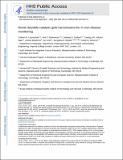| dc.contributor.author | Loynachan, Colleen N. | |
| dc.contributor.author | Soleimany, Ava P. | |
| dc.contributor.author | Dudani, Jaideep Sunil | |
| dc.contributor.author | Lin, Yiyang | |
| dc.contributor.author | Najer, Adrian | |
| dc.contributor.author | Bekdemir, Ahmet | |
| dc.contributor.author | Chen, Qu | |
| dc.contributor.author | Bhatia, Sangeeta N | |
| dc.contributor.author | Stevens, Molly M. | |
| dc.date.accessioned | 2020-12-04T17:11:32Z | |
| dc.date.available | 2020-12-04T17:11:32Z | |
| dc.date.issued | 2019-09 | |
| dc.date.submitted | 2018-11 | |
| dc.identifier.issn | 1748-3387 | |
| dc.identifier.issn | 1748-3395 | |
| dc.identifier.uri | https://hdl.handle.net/1721.1/128729 | |
| dc.description.abstract | Ultrasmall gold nanoclusters (AuNCs) have emerged as agile probes for in vivo imaging, as they exhibit exceptional tumour accumulation and efficient renal clearance properties. However, their intrinsic catalytic activity, which can enable an increased detection sensitivity, has yet to be explored for in vivo sensing. By exploiting the peroxidase-mimicking activity of AuNCs and the precise nanometre-size filtration of the kidney, we designed multifunctional protease nanosensors that respond to disease microenvironments to produce a direct colorimetric urinary readout of the disease state in less than one hour. We monitored the catalytic activity of AuNCs in the collected urine of a mouse model of colorectal cancer in which tumour-bearing mice showed a 13-fold increase in colorimetric signal compared to healthy mice. The nanosensors were eliminated completely through hepatic and renal excretion within four weeks of injection with no evidence of toxicity. We envision that this modular approach will enable the rapid detection of a diverse range of diseases by exploiting their specific enzymatic signatures. | en_US |
| dc.description.sponsorship | National Institute of Environmental Health Sciences (Grant P30-ES002109) | en_US |
| dc.description.sponsorship | NIH/NIGMS (Grant T32-GM008313) | en_US |
| dc.language.iso | en | |
| dc.publisher | Springer Science and Business Media LLC | en_US |
| dc.relation.isversionof | http://dx.doi.org/10.1038/s41565-019-0527-6 | en_US |
| dc.rights | Article is made available in accordance with the publisher's policy and may be subject to US copyright law. Please refer to the publisher's site for terms of use. | en_US |
| dc.source | PMC | en_US |
| dc.title | Renal clearable catalytic gold nanoclusters for in vivo disease monitoring | en_US |
| dc.type | Article | en_US |
| dc.identifier.citation | Loynachan, Colleen N. et al. "Renal clearable catalytic gold nanoclusters for in vivo disease monitoring." Nature Nanotechnology 14, 9 (September 2019): 883–890 © 2019 The Author(s). | en_US |
| dc.contributor.department | Massachusetts Institute of Technology. Department of Biological Engineering | en_US |
| dc.contributor.department | Harvard University--MIT Division of Health Sciences and Technology | en_US |
| dc.contributor.department | Massachusetts Institute of Technology. Institute for Medical Engineering & Science | en_US |
| dc.contributor.department | Massachusetts Institute of Technology. Department of Electrical Engineering and Computer Science | en_US |
| dc.contributor.department | Koch Institute for Integrative Cancer Research at MIT | en_US |
| dc.relation.journal | Nature Nanotechnology | en_US |
| dc.eprint.version | Author's final manuscript | en_US |
| dc.type.uri | http://purl.org/eprint/type/JournalArticle | en_US |
| eprint.status | http://purl.org/eprint/status/PeerReviewed | en_US |
| dc.date.updated | 2020-12-02T17:30:57Z | |
| dspace.orderedauthors | Loynachan, CN; Soleimany, AP; Dudani, JS; Lin, Y; Najer, A; Bekdemir, A; Chen, Q; Bhatia, SN; Stevens, MM | en_US |
| dspace.date.submission | 2020-12-02T17:31:02Z | |
| mit.journal.volume | 14 | en_US |
| mit.journal.issue | 9 | en_US |
| mit.license | PUBLISHER_POLICY | |
| mit.metadata.status | Complete | |
